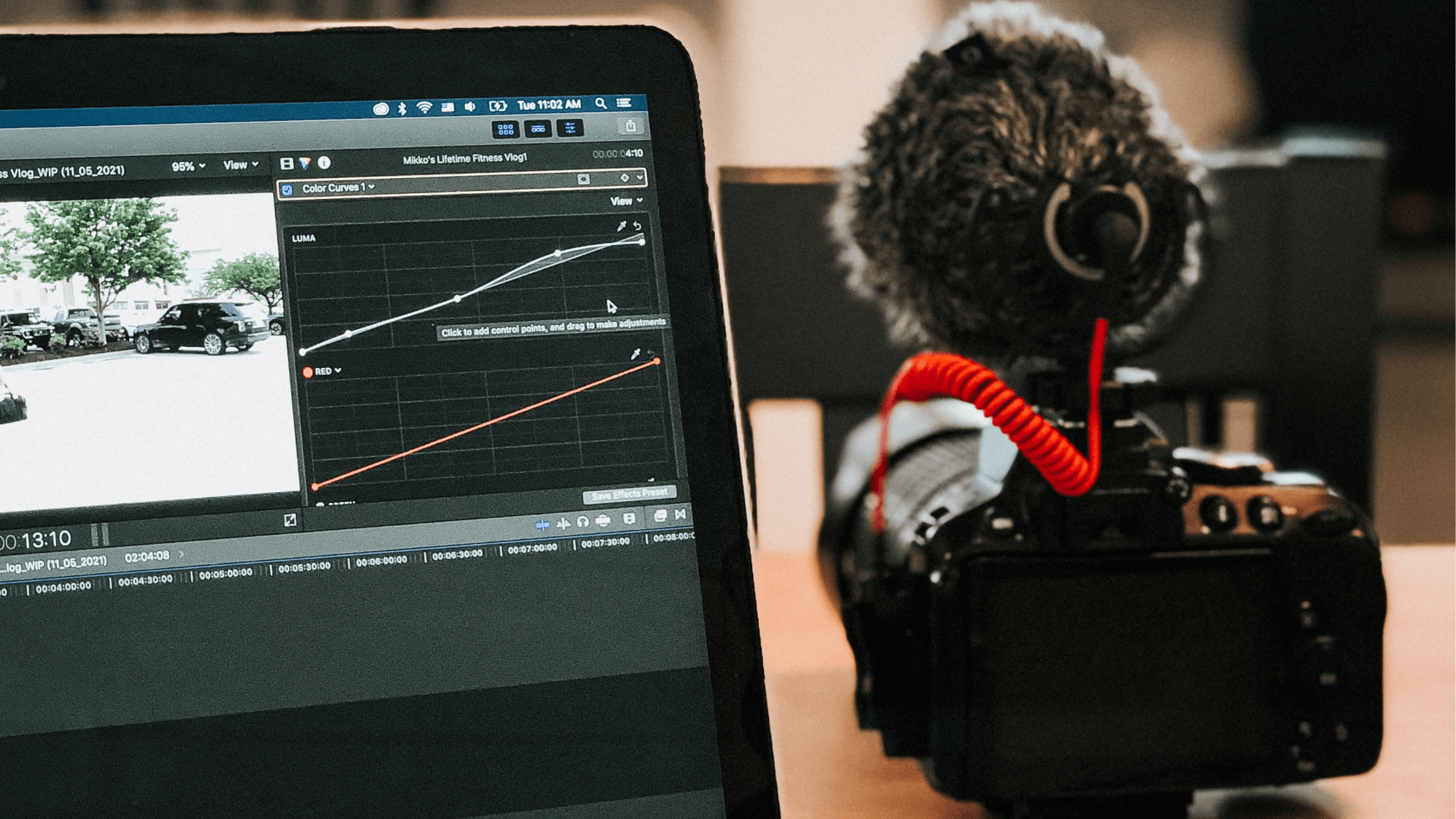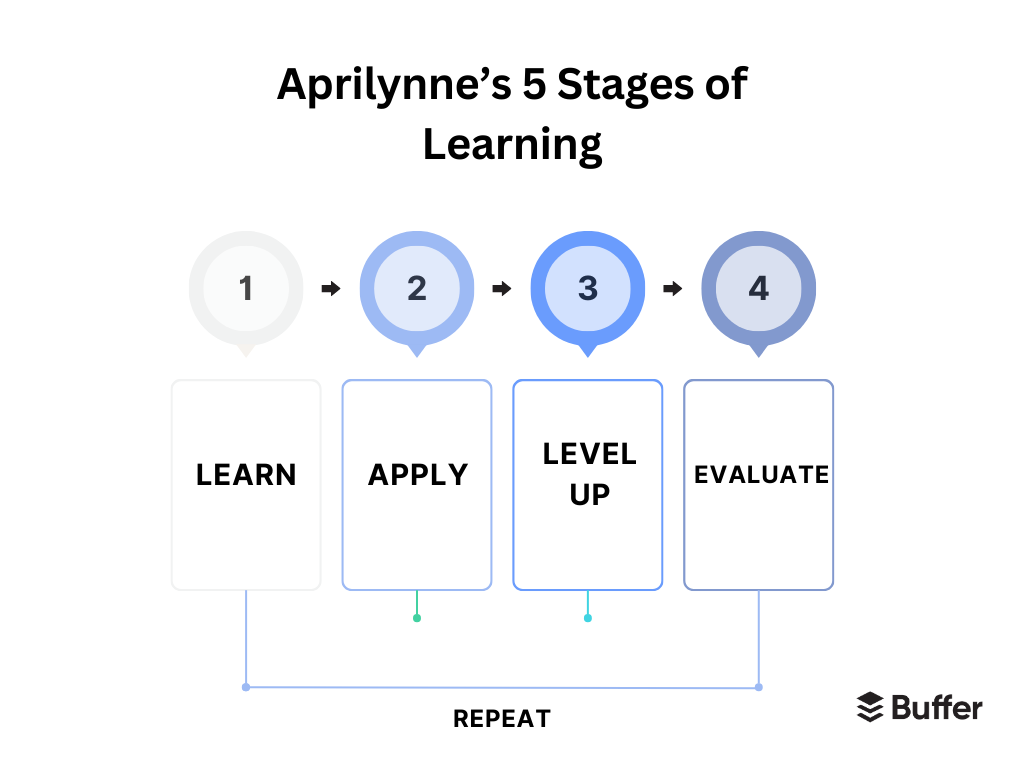
This Creator Grew to 20k+ YouTube Subscribers – Then She Started From Scratch
In this article, Aprilynne Alter shares her creator journey so far, including a sharp pivot, what it took to leave that audience behind, and advice for creators in similar situations.
Content Writer @ Buffer
When Aprilynne Alter started her YouTube channel in 2021, she didn’t expect it to grow the way it did. Her content about learning how NFTs work and documenting her progress in creating them attracted an audience of more than 22,000 subscribers. In the process, she learned how to grow on YouTube and gained an appreciation for the medium.
But NFTs and the broader web3 space weren’t Aprilynne’s topic of choice. So, she pivoted. Sharply.
She left her YouTube channel with over 22,000 subscribers and started a new one in April 2023. Now, she has 951 subscribers and more than 20,000 followers on Twitter. In this article, she shared her creator journey so far, including the sharp pivot, what it took to leave that audience behind, and advice for creators in similar situations.
Starting a new YouTube audience from scratch
Aprilynne had been making more general videos about joining and quitting Wall Street and trying to grow as a freelancer. While some of her videos performed great, success was slow. “My first YouTube channel was a bit of a mishmash. I was repurposing Twitter threads into videos, but it wasn't resonating with the YouTube audience.”
Then, a mix of the Web3 boom of 2021, the right timing, and Aprilynne’s content strategy and style led to rapid growth, and she monetized the channel quickly. “I made a video about my NFT journey, and it blew up. Suddenly, I had to decide: Do I ride this NFT wave or stick to my original, more general content?”
Her videos on learning about NFTs and making her own brought in thousands of subscribers. However, she realized she wasn't passionate about the topic of NFTs, so she faced a choice: to continue making content she wasn't passionate about to maintain growth or pivot to something else.
“The thing about niching down is that it's a double-edged sword. On the one hand, it helps you grow quickly. YouTube's algorithm loves it when it can easily categorize your audience. But on the flip side, if you're not passionate about that niche, you're setting yourself up for burnout. That's what happened to me with NFTs. I was creating content I didn't care about, just to ride the popularity wave. Six months in, I couldn't stand the sight of the word ‘NFT.’”
Aprilynne took a break from YouTube to reassess her interests and skills, and she realized she loved the process of making YouTube videos and was good at it, so she turned her efforts to the "How to YouTube" niche, specifically targeting educational content creators.
Now, she’s back to the basics on YouTube. “When I started my new channel, I was cautious. I knew the power of having a niche, but I also knew the pitfalls. I chose a niche I was genuinely interested in—educational videos that people actually want to watch and learn from. This time, it wasn't just about what was popular; it was about what I could sustainably create content about.”
Pivoting from one niche to another
Starting over is no small feat, especially when you've already built something, as Aprilynne can attest.
Although she could have slowly pivoted her existing YouTube channel to her new niche, she decided to start a whole new one. She shared some of her top lessons from her journey so far.
- Expectations vs. reality: “I thought my previous YouTube experience would give me a head start, and while it did to some extent, growth is still slower than I'd like. If I could go back, I'd tell myself, ‘Hey, slow your roll. This is a marathon, not a sprint. Get comfy with the pace.’”
- Understanding the best formats for you: “Now about short-form content. Everyone's raving about it, right? ‘Do Shorts, they said. It'll be fun, they said.’ Well, I tried it, and honestly, it didn't do much for me. The views were meh, and the conversion rate for subscribers was even worse. So, if I could do it over, I'd skip the shorts and focus on what I'm genuinely passionate about – long-form content. That's where I can add real value and connect with my audience more deeply.”
- Ripping off the Band-Aid: “Many other creators have pivoted. Ali Abdaal is a great example – he went from talking about his experiences as a student to productivity to his current content. But I went cold turkey. It's like ripping off a Band-Aid; it stings at first, but then you're glad you did it.”
“I'm still in the trenches, figuring things out as I go, but I'm proud of the progress I've made,” says Aprilynne. She summed up her advice to her past self this way:
- Be patient; growth takes time.
- Don't chase trends or formats that don't align with your passion or content strategy.
- Trust your gut. If something feels off, it probably is.
Understanding your audience as a creator
Aprilynne’s work as a YouTuber is just one aspect of her content creation matrix. She’s also grown a significant Twitter following (currently at over 20,000 followers) and created a course for beginner YouTubers. Her understanding of her audience has deepened since she started as a creator, and she shared some advice for developing that understanding.
“Understanding your audience is like detective work. You have to go where they hang out, listen to their conversations, and really get into their mindset. It's not just about what you want to say but also about what they need to hear,” she shares.
The concept of "collecting pain" is crucial to Aprilynne’s creative efforts. For her, it's not just about identifying a niche but understanding its specific problems, fears, and aspirations. Once you know the pain points, you can tailor your content to offer solutions, and that's when you really start to resonate with people.
However, this isn't a one-time thing. Audience needs and pain points can evolve, so it's good to make this a regular practice, revisiting those watering holes to keep your finger on the pulse.
For anyone struggling to identify their audience, start by being a good listener. Go to where your audience likely hangs out, whether it's Reddit, specific Twitter threads, or even comments on similar YouTube channels. Gather that intel and use it to inform your content strategy.
Finding a balance between past lessons and new strategies
Thanks to her past experience, Aprilynne can translate her lessons into valuable advice for her new audience. However, it’s important to keep learning. You reach a point where you've squeezed every drop of juice out of the lemon, so to speak, and you need to go find a new orchard.
Creators need to keep learning because the digital landscape is always changing. You can't just rest on your laurels – you have to adapt and evolve, and sometimes that means seeking out new knowledge and perspectives to keep growing.
Last week, I launched my first NFT collection
— Aprilynne Alter (@AprilynneAlter) November 1, 2021
Here's a breakdown of how I did it, what I learned, how much money I made, and whether or not I thought it was worth it
Let's get to it!
“In terms of the balance between past lessons and new strategies, I'd say it's a solid 70/30 split for me. About 70 percent of what I'm doing now is built on the foundation of what I've learned from growing my previous channel and my Twitter presence. That includes understanding the algorithm, knowing how to engage with my audience and even some technical stuff like video editing and SEO,” shares Aprilynne.
The remaining 30 percent is focused on exploring new territory – experimenting with different content formats, trying out new platforms if they align with her goals, and re-evaluating platforms that didn't work for her in the past. “Sometimes the timing just wasn't right, or maybe the platform itself has evolved,” she adds.
For Aprilynne, learning is continuous – investing in a program or course is like leveling up, following a cycle of Learn > Apply > Evaluate > Level up > Repeat. It's a way to acquire new tools and strategies you didn't even know you needed.

She shared, “If I've reached a point where I feel like I've applied everything I know, then it's time to go back to the drawing board, learn some new strategies, and then apply those. It's all about that balance and knowing when it's time to shift gears. And honestly, that's one of the things I love about this field. It keeps you on your toes; you're always learning, always adapting. It's never stagnant, and there's always room for growth.”
However, just as you can't keep applying the same strategies and expect different results, especially in a field as dynamic as content creation, you can’t just be in perpetual learning mode without applying what you've learned. Otherwise, you're just hoarding knowledge without any real-world impact.
Building in public as a catalyst for growth
Aprilynne’s journey has been boosted by her willingness to be transparent online. She shares, “When I first delved into the world of Twitter, I was clueless. I wasn't quite sure how to navigate the platform or how to engage with others effectively. But instead of giving up, I decided to document my learning process. And as I hit certain milestones and celebrated my successes, something unexpected happened. People started following me because they were also trying to learn how to use Twitter.”
I've made $6,537 in 3 months from YouTube 💰
— Aprilynne Alter (@AprilynneAlter) March 1, 2022
Almost everything I know about YouTube has come from @AliAbdaal's Part-Time YouTuber Academy 🎬
Here are my top 40 takeaways from PTYA 👇
In the process, she found that sharing her insights and experiences was incredibly helpful to others. “My Twitter account became like a public diary where I tried out different strategies and shared my triumphs and struggles. And what I found was that people particularly enjoyed my success threads, where I detailed how I achieved certain milestones on the platform,” she added.
Beyond success on Twitter, Aprilynne has been invited to give guest lectures on YouTube and has even been paid $1,000 for a one-hour workshop. When she was unsure how much to charge for sponsorships on her YouTube channel, she asked for advice online and met her now real-life partner in the process.
PSA: I met my partner on Twitter. We've now been living together for over a year and a half 💕
— Aprilynne Alter (@AprilynneAlter) August 20, 2023
Slide into those DMs, people
You never know what may happen 🤷♀️
“It's hard to believe that just by sharing my experiences online, I've forged meaningful connections and partnerships that have enriched my life in so many ways. I never could have imagined that simply sharing my journey could lead to such incredible things.”
Overall, sharing online has truly been a game-changer for Aprilynne. “It's like your transparency acts as a magnet, attracting the right opportunities and people into your life. You're not just sharing for the sake of sharing; you're providing value, insights, and even a sense of community for people who are on similar journeys. That's powerful.”
A five-step plan for fellow creator-educators
With her new (and former) niche, Aprilynne falls squarely into the creator-educator camp, and she shared some advice for fellow creators. So to conclude, here’s a five-step plan for anyone looking to share their expertise, according to Aprilynne.
- Identify your niche: First off, you need to nail down your niche. Let's say you've been in software development for a decade; your overall topic might be front-end development. But you must go deeper—what's your unique angle or insight? This is crucial because the internet is flooded with information. Why should someone listen to you over anyone else? So, step one is to dig deep into that unique angle.
- Choose your platform: Next, decide which platform to focus on. Many new creators try to be everywhere—Twitter, YouTube, Instagram, TikTok—and it becomes overwhelming. You lose consistency, growth stalls, and you get discouraged. So, pick one platform to start with. Twitter and YouTube are my strong suits, so I can offer more specific advice there.
- Perform keyword research on YouTube: If you choose YouTube, start with keyword research. Use an incognito tab to see what auto-fills when you type your topic. This will give you an idea of what people are searching for. I use a Chrome extension called Tube Buddy to get keyword scores showing search volume and competition. You want high search volume and low competition.
- Engage authentically on Twitter: Start by following people in your niche, especially those with a smaller following. Engage with them authentically; you're more likely to get a response. As you grow, level up who you're following and engaging with. Spend most of your time commenting on other people's tweets and the rest creating your content. Threads work well on Twitter.
- Commit to a time frame: Finally, come in with the expectation that you won't get a lot of views or impressions at the start. Commit to a specific timeframe—six months or a year—and stick with it, even if you get discouraged.
Whether you're a software developer with a decade of experience or someone just starting out, these steps can help you build a platform that shares your unique insights and genuinely helps people.
Try Buffer for free
140,000+ small businesses like yours use Buffer to build their brand on social media every month
Get started nowRelated Articles

Sending ads by mail may seem like a thing of the past, but this marketer thinks it’s a surprisingly effective approach for e-commerce brands.

In this article, we'll explore the unique characteristics of organic and paid social media, how they complement each other, and why incorporating both into your social media strategy is essential for achieving your business goals.

Whether you’re a full-time content creator, micro-influencer, nano-influencer, or just getting started, here’s how to create your own influencer media kit.